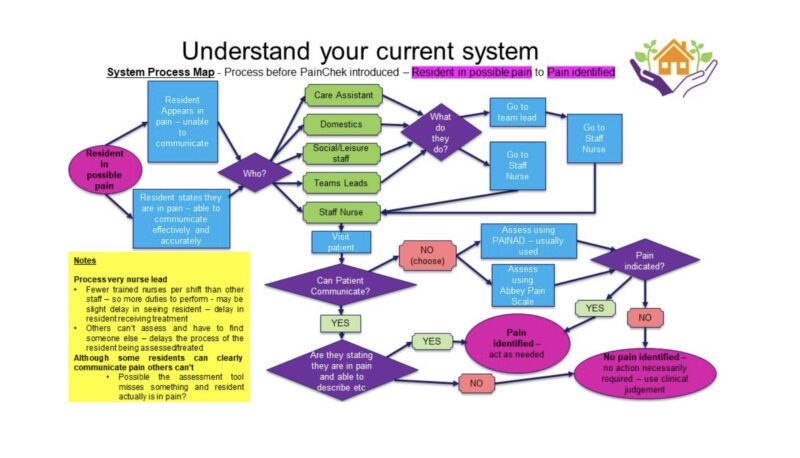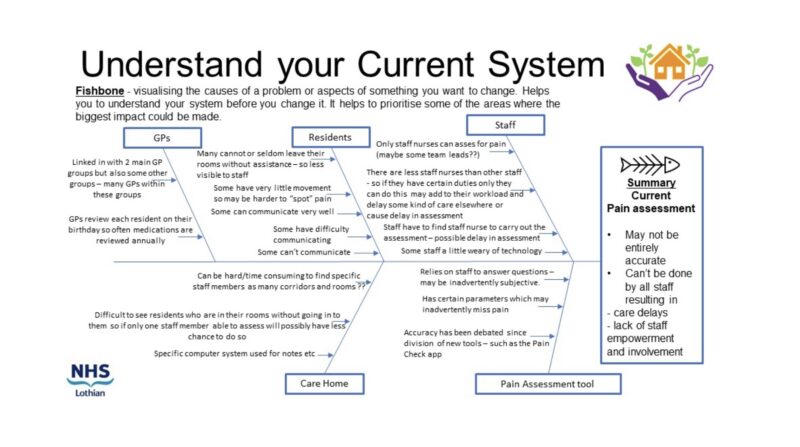Understanding pain from a patient’s perspective
Earlier in the year, I met with Cheryl Henderson, Education and Dementia Coordinator for Elder Homes based in Edinburgh. Elder Homes is a family run business with two homes, Cluny Lodge and Chamberlain house in Edinburgh. Their aim is to provide ‘elderly living with purpose.’
One of their priorities was to find ways for service users to better communicate their pain management needs. Staff told me that over the years they had utilised a number of pain assessment tools, but with mixed results.
Managing pain is integral to improving quality of life. Worldwide, it is estimated that 2-5% of the population live in residential or nursing homes. For people living with multiple medical conditions, an added complication arises when the experience of pain is coupled with the loss of communication skills.
A recent study found a rising trend in the percentage of people around the world who are living with physical pain. For a person with an illness like dementia, which can result in significant cognitive impairment, it can become extremely difficult for them to express what is wrong. This is especially true for those with limited verbal skills. Nursing and support staff often have to rely on trying to read facial expressions or behaviour to assess pain.
As a nurse, I was always taught the famous quote that pain is ‘whatever the experiencing person says it is, existing whenever and wherever the person says it does’. This quote has been used for many years, indeed as early as 1968. It is attributed to Margo McCaffery, an American registered nurse who was a pioneer in the field of pain management.
Through their research, Elder Homes learned of advancements in digital medical devices available for assessing and managing pain, and decided to do some testing of their own. They set up a trial using a device called PainChek that was developed specifically to improve pain assessment for people living with dementia and other cognitive impairment.
Getting the right support
As many readers will know, bringing about the change in behaviour and practice necessary to improve quality in any organisation or team can be hard and slow. Despite the best efforts, teams frequently encounter obstacles to achieving their goals.
Everyone involved in the project knew that it was important to ensure residents, relatives and staff were all part of the change. To provide them with the best chance of success, Elder Homes asked the NHS Lothian Quality Improvement Team for Care Homes and Primary Care Settings for support. This team supports organisations who want to take their ideas and innovations and transform them into evidence-based, measurable improvement in quality of care.
With any improvement work it is important to have regular team discussions to understand what is going well and what could be better. The QI team spent time training the staff on how to use the new medical device and measure evidence improvement.
In evaluating this project, all of the partners involved became more aware of variation between units and staff groups. This is an essential insight when working through any change process. It has become a valuable knowledge base that all of those involved can build on in future collaborations.
Applying PDSA methodology
Using PDSA (Plan, Do, Study and Act) cycles and data collected from the digital dashboard, the project has found new ways of helping individuals to collaborate with staff in identifying their pain needs, even where they have limited ability to communicate.
Along the way, the project has allowed staff the chance to learn a new method of assessment, whilst also developing a teaching method suited to the team’s needs and individual learning styles.
Staff reflections on working through the QI process
When the project phase concluded, I spent some time with the nursing team to ask them what they thought about implementing a piece of QI work using digital technology to help manage pain. I asked them what went well, and what they might do differently in future. These were some of their reflections:
Cheryl Henderson, Education and Dementia Co-ordinator said:
‘While the project was not without its challenges, overall it was a positive learning experience and we have built our QI capacity within the team.
‘Working with the QI team and having their expertise and support was key. They were very respectful towards residents and the team. The exchange of knowledge has been really positive for the organisation and, I hope, the QI team.’
Hazel Stewart, Associate Quality Improvement Advisor, at NHS Lothian’s quality improvement team for care homes and primary care settings, said:
‘We were able to see first hand the change process and staff becoming more engaged in using technology. We had the opportunity to use and demonstrate the benefits of different QI tools.’
Using visualisation tools in QI
To encourage team working and a greater understanding of the change process, the team used a system process map and a fishbone diagram. These visual tools helped everyone to both see and understand the workflow and to identify problems and opportunities to improve.

In this case, both the system process map and the fishbone diagram highlighted some possible areas for improvement and change.

For example, it was clear that pain assessment was very nurse-led (with possible associated issues) and pain assessment tools could to a degree be subjective (such as trying to read facial expressions) and present problems in assessing residents who had issues with communication. Having this insight allowed the team to consider a more objective, data-based approach using a digital medical device.
Moving from a nurse-led to a team based approach to pain management
With education and training on how to use the new digital device, any member of staff, not only a registered nurse, would be able to carry out pain assessment using the service user’s own data. This approach would allow more members of the team to be able to respond to service user’s pain management needs, leading to better quality of care overall.
Additionally, the use of a digital device meant that the team could gather more consistent, high quality data about each service user’s experience of their pain. This is a key element in personalising each individual’s care, including their pain management plan.
The visualisation tools put the project in a strong starting point. As the work progressed, the team had many learning opportunities which they used to continually refine their approach.
What happens next
Service users in Elder Homes are now able to use the PainChek app to let staff know how their pain levels are, giving them much more freedom to enjoy their day to day lives.
The next phase of this work is to study the application of digital technology in pain management in a care home setting. The team will gather evidence and evaluate the project and the outcome of this work will inform further improvements.
Staff have given positive feedback about the education sessions where they learn about how to use PainChek. Data suggests that the sessions have engaged staff and encouraged them to use PainChek for providing follow-up care, recording comments and making medication notes.
Comments
Carol Dale 6 Jul 2023
Hi
Can you provide more detail please?
Are you looking for support for a quality improvement report/assignment.